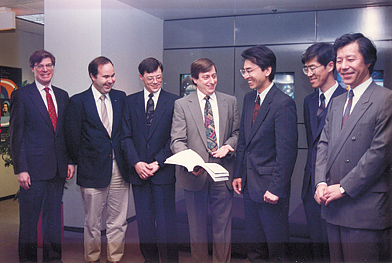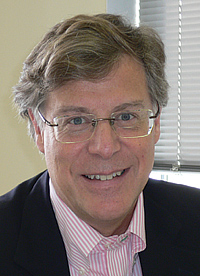Digital's Early Days
WASHINGTON
Before there was DTV or digital-anything, there was HDTV.
"At the start, we could consider only analog HDTV and not multiple services," said Dr. John Abel, who helped spearhead some early NAB efforts to assess HDTV's potential. Under the direction of its chief executive, Eddie Fritts, NAB began showing signs of interest in new technologies in the mid-1980s when it appeared the "new media" of the day (primarily cable, DBS and land mobile) were looking for a piece of the action—and a piece of the spectrum that broadcasters had long considered sacrosanct.
One particular chapter in NAB's initial queries into HDTV in 1986 was chronicled more than a decade later in a book by Pulitzer Prize-winning journalist Joel Brinkley, in "Defining Vision: The Battle for the Future of Television." The book's opening pages detail a visit that Abel and Tom Keller (NAB's top technology officer) paid to Dr. William Glenn in Ft. Lauderdale, Fla. (Although few were aware of it, NAB had been providing funding to Glenn.)

Representatives from the U.S. charged with developing a new hi-def service receive a report on Japan’s MUSE system from NHK officials in 1992. The somewhat unorthodox Florida "meeting" took place in a non-descript trailer that gave no sign of the sophisticated tests going on within. "Dr. Glenn's approach was interesting, but also required about 9 MHz of spectrum—in effect, [signifying] a channel-and-a-half in order to support analog HD," Abel said.
The system getting all the attention was Japan's NHK MUSE. But as NAB slowly and carefully began alerting its station members to MUSE's potential, it was unclear to local stations how converting to costly "analog HDTV" would help them compete in a changing media landscape (although some still resisted the notion that anyone could really compete with broadcasters).
A 'GREAT STORY'
But even in 2009, the real impetus for eventually establishing DTV is still arguable. "I never agreed with the [Brinkley] assessment," said Peter Fannon, who was to head the Advanced Television Test Center (ATTC)—one of several DTV groups which received a Technical Emmy last month. "It made a great story. I'm sure inside NAB there was a strong effort to stop the [land mobile] industry from taking any more so-called broadcast spectrum. [But] MSTV, for one, was always worried about interference, and ALTV [Association of Local Television Stations], as it was called, was always trying to find ways to get additional stations up."
Fannon thinks the key factor that kept U.S. broadcasters looking over their shoulder was word that NHK had developed a satellite system—primarily because it had been spending $1 billion annually to service about 8,000 transmitters scattered across Japan's mountainous terrain.
"Satellites provided the real impetus for America going forward with HDTV," he said. "It scared the hell out of the American broadcaster, who feared all this would quite literally pass over them." Now a Panasonic executive, Fannon also recalls having heard periodic reports about HDTV years prior to the Abel-Keller visit to Florida.
Charles ("Charlie") Rhodes was among a handful of American engineers present at the table in the 1970s, to which Fannon alluded. Rhodes had represented America at a CCIR meeting (now called ITU) in Switzerland when he worked for Tektronix. "In those days, the Japanese were handing out HDTV brochures to anyone and everyone," Rhodes said. NHK's project was headed by Dr. Takashi Fujio, an expert in psycho-visual measurements.
Rhodes said NHK had pretty much determined that "HDTV was basically a large widescreen with over 1,000 lines." NHK was attacking the problem of improving TV from the basics of human vision, which Rhodes said was the right approach. Now a prominent consultant and columnist for TV Technology, Rhodes said his subsequent visits to NHK Labs had required signing a guest log—and while doing so he noted CBS engineers had been stopping by, too. "In 1981, CBS arranged to demonstrate HDTV in the U.S., starting off I think with SMPTE in San Francisco. This is how I became involved." (Rhodes would later serve as ATTC's chief scientist for the entire span of the group's existence.)
NOT MUCH ENTHUSIASM
By spring 1987, with Rhodes already on board, Abel asked Fannon (then a public TV lobbyist) to head the industry test center. But Fannon soon discovered the move toward a new technology was initially thwarted by apathy from many broadcasters and the ATTC board. "Most broadcasters either didn't give a damn, were dragging their feet, weren't paying attention, or were opposed," Fannon said.

Peter Fannon A year earlier in 1986, Richard Wiley, who chaired the FCC during the Ford administration, began his own key role in the meandering march toward DTV when he agreed to chair the FCC Advisory Committee on Advanced Television Service. His committee, too, had met some early resistance. "Dick Wiley shamed the cable guys into contributing to the committee," Fannon said.
"We did encounter more than a few… non-believers along the way," Wiley acknowledges. "The industry, broadly defined, was generally very supportive. But, yes, I did have to twist a few arms." About halfway through Wiley's nine-year tenure as committee chair, the term "digital" began appearing in proposals. In fact, within a few months every U.S. proponent of an HD analog system had withdrawn their proposal and introduced a digital system in its place.
Wiley said the essential step leading to an ATSC standard, which was approved by the FCC in 1996, had been formation of the Grand Alliance, which pooled the best parts of several competing proposals. "Without the Grand Alliance, we would have spent years in legislative struggles and litigation," Wiley said. He's also careful to note the contributions of American technical experts from a wide array of companies and groups—"really the cream of our nation's video engineering community."
Mark Richer, who now heads the ATSC, agrees: "Whenever I think back on the early days of ATSC, HDTV and the FCC advisory committee, it's the people I think about more than the technology." Richer chaired SSWP2, the group responsible for testing proponent systems. At the time an engineering executive at PBS, Richer concurs that the advisory committee process was difficult, but Wiley handled it well. "Dick always served popcorn at those meetings. To this day, if I smell popcorn, I start to think about those sessions."
Rhodes believes what was accomplished in the drive to DTV was "showing the world that HDTV of the same quality that NHK had demonstrated could be done digitally. We went even further by going into a digital packet-based means of transmitting luminance and chrominance information so available data rates could also support multicasting and other new services that were previously impossible."
The professional video industry's #1 source for news, trends and product and tech information. Sign up below.
